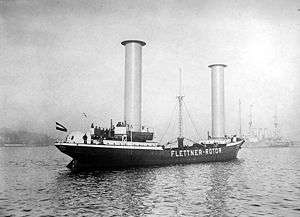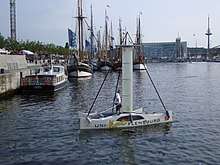Wind-assisted propulsion
Wind assisted propulsion is the practice of decreasing the fuel consumption of a merchant vessel through the use of sails or some other wind capture device. Sails used to be the primary means of propelling ships, but with the advent of the steam engine and the diesel engine, sails came to be used for recreational sailing only. In recent years with increasing fuel costs and an increased focus on reducing emissions, there has been increased interest in harnessing the power of the wind to propel commercial ships.
Design
The mechanical means of converting the kinetic energy of the wind into thrust for a ship is the subject of much recent study. Where early ships designed primarily for sailing were designed around the sails that propelled them, commercial ships are now designed largely around the cargo that they carry, requiring a large clear deck and minimal overhead rigging in order to facilitate cargo handling. Another design consideration in designing a sail propulsion system for a commercial ship is that in order for it to be economically advantageous it cannot require a significantly larger crew to operate and it cannot compromise the stability of the ship. Taking into account these design criteria, three main concepts have emerged as the leading designs for wind-assisted propulsion: the “Wing Sail Concept,” the “Kite Sail,” and the “Flettner Rotor.”
Wing sail concept
As a result of rising oil prices in the 1980s the US government commissioned a study on the economic feasibility of using wind assisted propulsion to reduce the fuel consumption of ships in the US Merchant Marine. This study considered five different designs and concluded that with current technology the design that offered the greatest benefit would be the “Wing Sail Concept.” The "Wing Sail Concept" would largely be an automated system of large rectangular solid sails supported by cylindrical masts. These would be symmetrical sails which would allow a minimal amount of handling to maintain the sail orientation for different wind angles, however this design was at the expense of increased efficiency. A small freighter was outfitted with this system to evaluate its actual fuel gains with the result that it was estimated to save between 15–25% of the vessel's fuel. Despite the positive findings of this study, the "Wing Sail Concept" failed to catch on and is not currently found on any commercial ships.[1]
Kite sail
The kite sail concept has recently received a lot of interest. This rig consists of flying a gigantic kite from the bow of a ship using the traction developed by the kite to assist in pulling the ship through the water. Other concepts that have been explored were designed to have the kite rig alternately pull out and retract on a reel driving a generator. The kite used in this setup is similar to the kites used by recreational kiteboarders on a much larger scale. This design also allows users to expand its scale by flying multiple kites in a stacked arrangement.
The idea of using kites is currently the most popular form of wind-assisted propulsion on commercial ships, largely due to the low cost of retrofitting the system to existing ships with minimal interference with existing structures. This system also allows a large amount of automation using computer controls to determine the ideal kite angle and position. Using a kite allows the capture of wind at greater altitudes where wind speed is higher and more consistent.[2] This system has seen use on several ships recently with the most notable being MS Beluga Skysails, a merchant ship chartered by the US Military Sealift Command to evaluate the claims of efficiency and the feasibility of fitting this system to other ships.[3]
Flettner Rotor


The third design considered is the Flettner Rotor. This is a large cylinder mounted upright on a ship's deck and mechanically spun. The effect of this spinning area in contact with the wind flowing around it creates a thrust effect that is used to propel the ship. Flettner Rotors were invented in the 1920s and have seen limited use since then. In 2010 a 10,000 dwt cargo ship was equipped with four Flettner Rotors to evaluate their role in increasing fuel efficiency. Since then, several Cargo Ships and a passenger ferry have been equipped with rotors. Recent examples include : "Viking Line has installed a Norsepower rotor sail unit on the cruise ferry Viking Grace, making her the world's only working passenger vessel with a modernized Flettner rotor. " [4] "Energy Technologies Institute and Shell, Norsepower installed two of its rotor sails aboard the LR2 tanker Maersk Pelican in August 2018" [5]


The only parameter of the Flettner Rotor requiring control is the speed of the rotor's rotation, so this method of wind propulsion requires very little operator input. In comparison to kite sails, Flettner rotors often offer considerable efficiency gains when compared to the size of a sail or kite vs. size of the rotor and prevailing wind conditions.[6]
Rising trends
The efficiency gains of these three propulsion assistance mechanisms are typically around 15–20% depending on the size of the sails. The main reason for the use of these mechanisms not being more widespread is mostly that shipping companies are unwilling to install untested equipment.[7] With government initiatives to encourage the decrease in emissions and rising fuel costs, it is probable that these propulsion systems will see more widespread use in the coming years.
See also
References
- Bergeson, Lloyd. (1981). Wind Propulsion for Ships of the American Merchant Marine. Springfield, VA: National Technical Information Service.
- Rizzuto, E. (2012). Sustainable Maritime Transportation and Exploitation of Sea Resources. London, UK: CRC Press
- Konrad, John. (2009, April). Mariners Weather Log Vol.53 No. 1. Retrieved from U.S. Department of Commerce website: http://www.vos.noaa.gov/MWL/apr_09/skysails.shtml
- https://www.maritime-executive.com/article/viking-line-installs-rotor-sail-on-cruise-ferry
- https://www.maritime-executive.com/article/flettner-rotor-trial-delivers-real-world-fuel-savings
- Traut Michael. (2014, January). Propulsive power contribution of a kite and a Flettner rotor on selected shipping routes. Applied Energy, 113, 362–372.
- Konrad, John. (2009, April). Mariners Weather Log Vol.53 No. 1. Retrieved from U.S. Department of Commerce website: http://www.vos.noaa.gov/MWL/apr_09/skysails.shtml